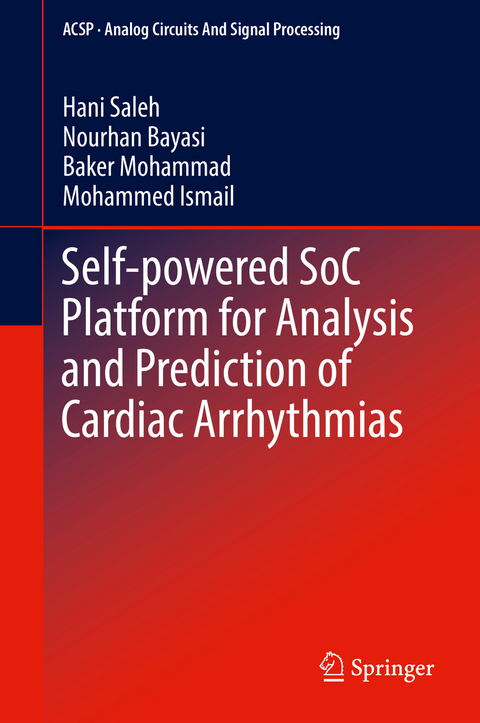
Self-powered SoC Platform for Analysis and Prediction of Cardiac Arrhythmias
Springer International Publishing (Verlag)
978-3-319-63972-7 (ISBN)
Hani Saleh is an Associate professor of electronic engineering at Khalifa University (KU), he joined KU since Jan, 2012. He is a co-founder and an active member in KSRC (Khalifa University Research Center) where he leads a project for the development of wearable blood glucose monitor SOC and a mobile surveillance SOC and safe exercise monitoring device. Hani published 90 articles in peer-reviewed journals and conferences, he has 8 issued US patents and 9 pending patent applications. Hani has a total of 19 years of industrial experience in ASIC chip design, microprocessor design, DSP core design, graphics core design and embedded system design. His experience spans DSP core design, microprocessor peripherals design, microprocessors and graphics core deign. Prior to joining Khalifa University he worked as a Senior Chip Designer (Technical Lead) at Apple incorporation; where he worked on the design and implementation of Apple next generation graphics cores for its mobile products (iPad, iPhone, ...etc.), prior to joining Apple, he worked for several leading semiconductor companies including Intel (ATOM mobile microprocessor design), AMD (Bobcat mobile microprocessor design), Qualcomm (QDSP DSP core design for mobile SOC's), Synopsys (a key member of Synopsys turnkey design group where he taped out many ASICs and designed the I2C DW IP included in Synopys DesignWare library), Fujitsu (SPARC compatible high performance microprocessor design) and Motorola Australia (M210 low power microprocessor synthesizable core design). Nourhan Bayasi (M'13) received the B.S. degree in electrical and computer engineering from the Khalifa University of Science, Technology and Research, Abu Dhabi, United Arab Emirates, in 2013, where she is currently pursuing the M.S. degree in electrical and computer engineering. Her research project focuses on system-on-chip design and implementation of a fully integrated wearable biomedical system. Her current research interests include designing analog and mixed-signals integrated circuits, low power circuit design, and digital signal processing and its application. Baker Mohammad (M'04-SM'13) received the B.S. degree from the University of New Mexico, Albuquerque, NM, USA, the M.S. degree from Arizona State University, Tempe, AZ, USA, and the Ph.D. degree from the University of Texas at Austin, Austin, TX, USA, in 2008, all in electrical and computer engineering. He was a Senior Staff Engineer and the Manager with Qualcomm, Austin, where he was involved in designing high performance and low power DSP processor used for communication and multimedia application. He was involved in a wide range of microprocessors design with Intel Corporation, Santa Clara, CA, USA, from high performance, server chips 100 W (IA-64), to mobile embedded processor low power sub-1 W (xscale). He has over 16 years of industrial experience in microprocessor design with an emphasis on memory, low power circuit, and physical design. He is currently an Associate Professor of Electronic Engineering with the Khalifa University of Science, Technology and Research, Abu Dhabi, United Arab Emirates, and a Consultant with Qualcomm Inc., San Diego, CA, USA. In addition, he is involved in microwatt range computing platform for WSN focusing on energy harvesting and power management, including efficient dc/dc and ac/dc converters. He holds ten issued U.S. patents and has several pending patent applications. He has authored one book entitled Embedded Memory Design for Multi-Core and SoC and co-authored several publications in digital system design, memory design and testing, energy harvesting, power management, and power conversion, in addition to emerging memory technology modeling and design. His current research interests include power efficient computing, high y
Introduction.- Literature Review.- System Design and Development.- Hardware Design and Implementation.- Performance and Result.- Conclusions.- Bibliography.- Index.
| Erscheinungsdatum | 14.11.2017 |
|---|---|
| Reihe/Serie | Analog Circuits and Signal Processing |
| Zusatzinfo | XVI, 74 p. 46 illus., 34 illus. in color. |
| Verlagsort | Cham |
| Sprache | englisch |
| Maße | 155 x 235 mm |
| Gewicht | 311 g |
| Themenwelt | Mathematik / Informatik ► Informatik ► Theorie / Studium |
| Medizin / Pharmazie ► Physiotherapie / Ergotherapie ► Orthopädie | |
| Technik ► Elektrotechnik / Energietechnik | |
| Schlagworte | biomedical engineering • Circuits and Systems • Circuits for Remote healthcare • computer architecture & logic design • Computer architecture & logic design • ECG Data Analysis • ECG remote processing • ECG Signal Processing, Classification and Interpre • ECG Signal Processing, Classification and Interpretation • electronics: Circuits & components • Electronics: circuits & components • Engineering • Engineering: general • Prediction of cardiac arrhythmias • prediction of VT/Vf • Processor Architectures |
| ISBN-10 | 3-319-63972-2 / 3319639722 |
| ISBN-13 | 978-3-319-63972-7 / 9783319639727 |
| Zustand | Neuware |
| Informationen gemäß Produktsicherheitsverordnung (GPSR) | |
| Haben Sie eine Frage zum Produkt? |
aus dem Bereich


